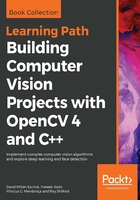
Object detection
Object detection refers to detecting the location of an object in a given image. This process is not concerned with the type of object. If you design a chair detector, it will not tell you whether the chair in a given image is red with a high back, or blue with a low back—it will just tell you the location of the chair.
Detecting the location of objects is a critical step in many computer vision systems. Consider the following photo:

If you run a chair detector on this image, it will put a green box around all the chairs—but it won't tell you what kind of chair it is.
Object detection used to be a computationally-intensive task because of the number of calculations required to perform the detection at various scales. To solve this, Paul Viola and Michael Jones came up with a great algorithm in their seminal 2001 paper, which you can read at the following link: https://www.cs.cmu.edu/~efros/courses/LBMV07/Papers/viola-cvpr-01.pdf. They provided a fast way to design an object detector for any object.
OpenCV has modules called objdetect and xobjdetect that provide the framework to design an object detector. You can use it to develop detectors for random items such as sunglasses, boots, and so on.